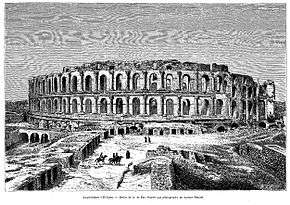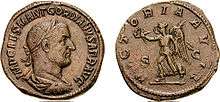Thysdrus
 Thysdrus's huge amphitheater | |
 Shown within Tunisia | |
| Location | Tunisia |
|---|---|
| Region | Mahdia Governorate |
| Coordinates | Coordinates: 35°18′00″N 10°43′00″E / 35.3°N 10.716667°E |
Thysdrus was a Roman-Berber colonia near present-day El Djem, Tunisia. It was served as the center of olive oil production in the province of Africa proconsularis, situated in the north-central area. The local Amphitheatre of El Jem has been a World Heritage Site since 1979.
History
The toponym Thysdrus has Berber roots. The city was founded by the Romans on the site of an ancient, small Berber Punic village.[1]
Thysdrus probably received Julius Caesar's veterans as settlers in 45 BC. Thysdrus did not become a "Municipium" (settlement with partial rights of citizenship) until the reign of Septimius Severus.[2] In 244 AD it was declared "Colonia" by emperor Gordian III.
In a less arid climate than today's, Thysdrus, which later became part of the Roman province of Byzacena, prospered especially in the 2nd century, when it became an important center of olive oil manufacturing for export. It was the seat of a Christian bishopric, which is included in the Catholic Church's list of titular sees.[3]

Thysdrus grew to be the main center of olive oil production in Roman Africa thanks to the Romano-berber emperor Septimius Severus and his successors. So, by the early 3rd century AD, when the huge amphitheater was built, Thysdrus rivaled Hadrumetum (modern Sousse) as the second city of Roman North Africa, after Carthage. The city had even a huge "Circus", nearly as large as the Circus Maximus at Rome and capable of accommodating about 30,000 spectators.
In 238 AD Thysdrus was at the center of a struggle to control the Roman Empire: Gordian I was helped by a riot of Thysdrus citizens and because of them was named emperor. All this happened after Maximinus Thrax killed Emperor Alexander Severus at Moguntiacum in Germania Inferior and assumed the throne.[4]
Maximinus was not a popular emperor and universal discontent roused by his oppressive rule culminated in a revolt in Africa in 238 AD.[5] The trigger was the actions of Maximinus’s procurator in Africa, who sought to extract the maximum level of taxation and fines possible, including falsifying charges against the local aristocracy.[5] A riot of Thysdrus inhabitants saw the death of the procurator, after which they turned to Gordian and demanded that he accept the dangerous honor of the imperial throne.[6] Gordian, after protesting that he was too old for the position, eventually yielded to the popular clamour of the Thysdrus citizens and assumed both the purple and the cognomen Africanus on March 22.[7]
According to Edward Gibbon:
An iniquitous sentence had been pronounced against some opulent youths of [Africa], the execution of which would have stripped them of far the greater part of their patrimony. (…) A respite of three days, obtained with difficulty from the rapacious treasurer, was employed in collecting from their estates a great number of slaves and peasants blindly devoted to the commands of their lords, and armed with the rustic weapons of clubs and axes. The leaders of the conspiracy, as they were admitted to the audience of the procurator, stabbed him with the daggers concealed under their garments, and, by the assistance of their tumultuary train, seized on the town of Thysdrus, and erected the standard of rebellion against the sovereign of the Roman empire. (...) Gordianus, their proconsul, and the object of their choice [as emperor], refused, with unfeigned reluctance, the dangerous honour, and begged with tears that they should suffer him to terminate in peace a long and innocent life, without staining his feeble age with civil blood. Their menaces compelled him to accept the Imperial purple, his only refuge indeed against the jealous cruelty of Maximin (...).[8]
Due to his advanced age, he insisted that his son, Marcus Antonius Gordianus (Gordian II), be associated with him.[6] A few days later, Gordian entered the city of Carthage with the overwhelming support of the population and local political leaders.[9] Meanwhile, in Rome, Maximinus' praetorian prefect was assassinated and the rebellion seemed to be successful.[10] Gordian in the meantime had sent an embassy to Rome, under the leadership of Publius Licinius Valerianus,[11] to obtain the Senate’s support for his rebellion.[10] The senate confirmed the new emperor on 2 April and many of the provinces gladly sided with Gordian.[12]
Opposition would come from the neighbouring province of Numidia.[13] Capelianus, governor of Numidia, loyal supporter of Maximinus Thrax, and who held a grudge against Gordian,[12] renewed his alliance to the former emperor and invaded Africa province with the only legion stationed in the region, III Augusta, and other veteran units.[14] Gordian II, at the head of a militia army of untrained soldiers mostly from Thysdrus and surroundings, lost the Battle of Carthage and was killed,[12] and Gordian took his own life by hanging himself with his belt.[5] The Gordians had reigned only thirty-six days.[15]
However, following the abortive revolt that began there in 238 AD, and Gordian I's suicide in his villa near Carthage, Roman troops loyal to the Emperor Maximinus Thrax destroyed the city of Thysdrus that had reached a population of nearly 50,000 inhabitants. It never really recovered, even if lasted as a small town until the Arab invasion in the seventh century.
Similar to the Colosseum of Rome and to the theatre of Bosra, the amphitheatre was turned into a fortress where local tribes tried to check the Arab invasion of the region after the Byzantines had been defeated at Sufetula in 647. In 670 the Arabs founded Kairouan, forty miles north of Thysdrus, and made it the capital of the country. This fact, associated with the arrival of Arab nomadic tribes which led to the abandonment of farming, caused the decline of Thysdrus. Roberto Piperno [16]
The Romano-berber queen Kahina in her final attempt to stop the Arab invasion around 695 AD destroyed most of the olive trees of the Thysdrus area and used the amphitheater as a last defence, but was defeated.
In the next centuries Thysdrus simply "disappeared" with the worsening arid climate that damaged the olive oil production, and by the tenth century many of the Thysdrus buildings were dismantled and used as stones for the Arab Kairouan. In the nineteenth century the French colonists found only a small village, named El Djem, with a few hundred inhabitants living around the remains of the amphitheater and surviving in very poor subsistence conditions.
Notes
- ↑ Thysdrus history (in Italian)
- ↑ JSTOR: Thysdrus
- ↑ Annuario Pontificio 2013 (Libreria Editrice Vaticana, 2013, ISBN 978-88-209-9070-1), p. 992
- ↑ Potter, pg. 167
- 1 2 3 Canduci, pg. 63
- 1 2 Southern, pg. 66
- ↑ Herodian, 7:5:8
- ↑ Gibbon, The History of the Decline and Fall of the Roman Empire, Vol. I, Ch. 7
- ↑ Herodian, 7:6:2
- 1 2 Potter, pg. 169
- ↑ Zosimus, 1:11
- 1 2 3 Potter, pg. 170
- ↑ Southern, pg. 67
- ↑ Herodian, 7:9:3
- ↑ Meckler, Gordian I
- ↑ Thysdrus history and photos
Bibliography
- Gibbon. Edward Decline and Fall of the Roman Empire (1888)
- Herodian, Roman History, Book 7
- Southern, Pat. The Roman Empire from Severus to Constantine, Routledge, 2001
- Syme, Ronald, Emperors and Biography, Oxford University Press, 1971
- Potter, David Stone, The Roman Empire at Bay, AD 180-395, Routledge, 2004
- Birley, Anthony (2005), The Roman Government in Britain, Oxford University Press, ISBN 978-0-19-925237-4
- Canduci, Alexander (2010), Triumph & Tragedy: The Rise and Fall of Rome's Immortal Emperors, Pier 9, ISBN 978-1-74196-598-8
- Zosimus, Historia Nova
%2C_Algeria_04966r.jpg)